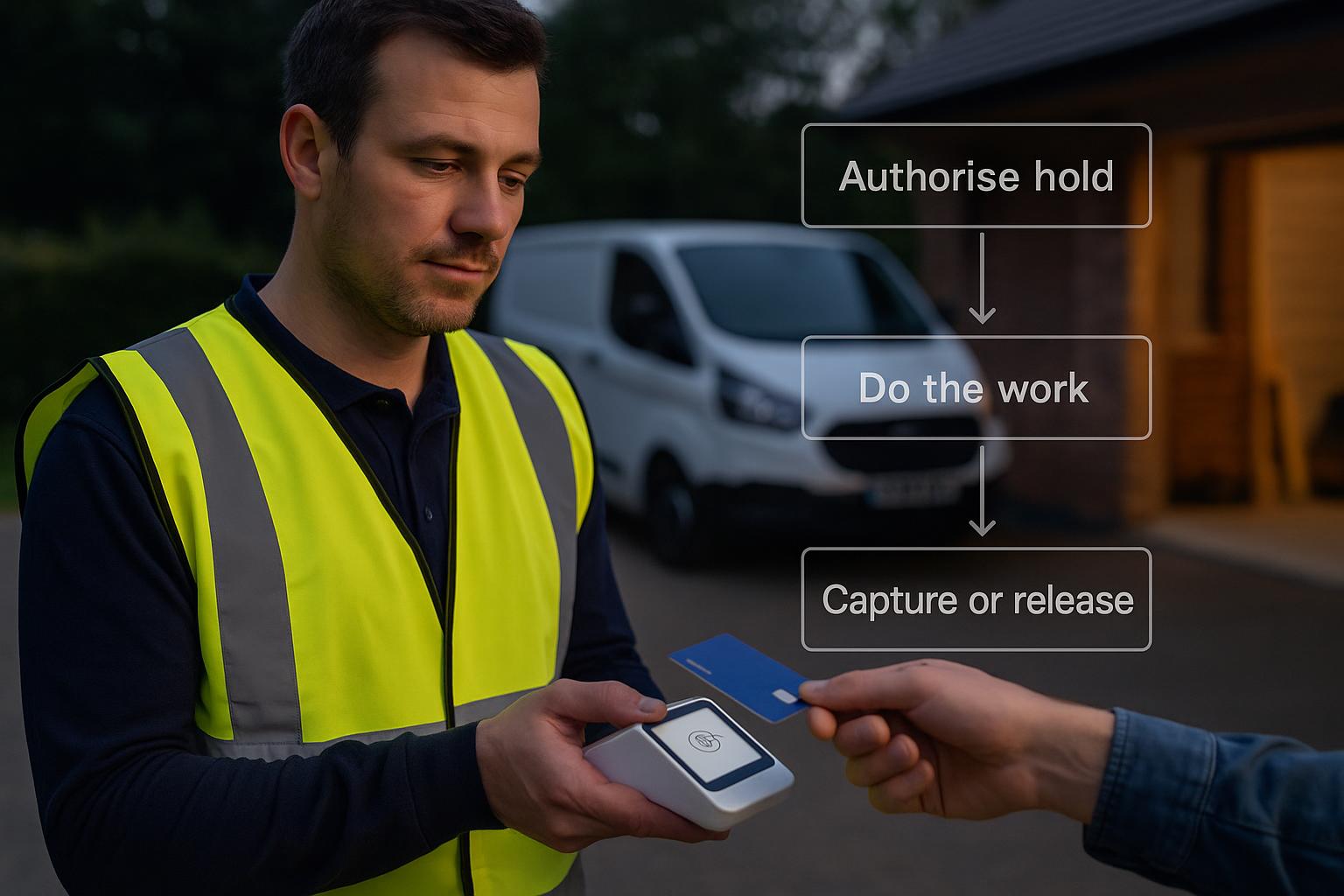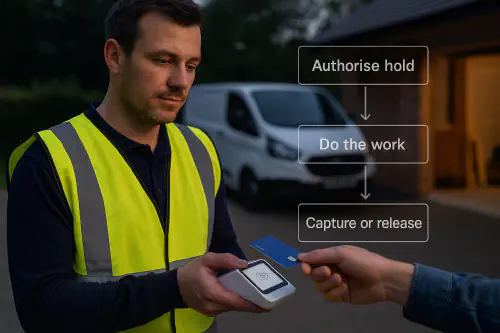
How to take a card pre-authorisation on site with Square (and when to use deposits instead)
How to take a card pre-authorisation on site with Square (and when to use deposits instead)
Category: Tools, Materials & Tech • Niche: card readers, pre-authorisation, delayed capture, chargebacks, rural jobs

Tradesperson using a Square Terminal to place a card pre-authorisation on site
Contents
- Quick answer
- When to use a pre-authorisation vs a deposit
- What Square supports in the UK
- Set up a pre-authorisation on Square
- Capture, adjust or void the hold
- No signal on site? Safe fallbacks
- Evidence that wins disputes
- FAQs
Quick answer
- A pre-authorisation places a temporary hold on a customer’s card so you can capture funds later when the job is complete. In Square UK, this is supported as a delayed capture/pre-authorise flow. Holds on card-present Square checkouts typically last about 36 hours before they expire if not captured.
- Use pre-auth for short jobs where the final amount may change slightly (tipping, extras, small variations). If there’s a long gap between authorise and finish, or you’re on weak signal, use a deposit instead.
When to use a pre-authorisation vs a deposit
- Use a pre-auth when:
- You expect to finish and collect within hours, not days.
- The final total may be a bit higher or lower than the estimate (e.g., minor materials, extra labour hour).
- You want to reduce refund admin and keep a seamless on-site checkout.
- Use a deposit when:
- Work spans days/weeks, or materials are bespoke.
- You need to secure cash flow ahead of ordering.
- You’re likely to be outside Square’s capture window (about 36 hours for in-person holds).
- UK consumer law: keep terms fair and clear; if you call a payment a “non-refundable deposit”, make sure that’s reasonable and explained upfront. See Citizens Advice guidance on staged payments and deposits.
What Square supports in the UK
- Square supports pre-authorisation (authorise now, capture later) for in-person payments in the UK via its POS apps and Terminal API. Holds typically last ~36 hours for card-present.
- Offline Mode does not support pre-auth. You need live signal to authorise.
- Square’s developer docs call this “delayed capture.” Square’s UK support article covers enabling bar tab pre-authorisation and notes device support and timing windows.
Useful references:
- Square UK support: enable and configure pre-authorisation for bar tabs (covers timing windows and devices).
- Square developer docs: Delayed capture with Payments API and Terminal API.
Set up a pre-authorisation on Square
Step-by-step (Square POS or Restaurants):
- In Settings, enable pre-authorisation for tabs if your POS flow supports it.
- Start a new sale/tab; insert card to capture the cardholder name (taps may not capture name info).
- Choose a pre-authorise amount (estimate what you’ll need). Avoid excessive buffers.
- Authorise. The customer will see a pending hold on their statement.
- Do the work.
Square Terminal API approach (for integrators):
- Use a Terminal checkout with delayed capture. The payment remains authorised (pending) and must be captured within ~36 hours for in-person flows.
Capture, adjust or void the hold
- Capture: when the job is done, add any extras and capture up to the authorised amount. If you need to increase, capture can include a higher amount where supported, or you can add a new charge for the difference.
- Reduce: if final comes in lower, capture the exact lower amount.
- Void: if the job doesn’t go ahead, void the authorisation so the hold drops off. Customers may still see pending lines for a few days as banks update.
- Timing: don’t miss the capture window. If it expires, you’ll need to authorise again with the customer present.
No signal on site? Safe fallbacks
If you can’t get signal, don’t attempt pre-auth. Use a deposit workflow instead:
- Send a payment link or invoice to the customer’s phone while you have Wi-Fi, or at the office before the visit.
- For rural driveways and gardens, print a QR code for your standard deposit link so the customer can pay later on home Wi‑Fi.
- As a last resort, bank transfer to your business account on the day, with a clear reference (job number). Confirm receipt before starting.
Related reading: Card machine says no signal? How to take payments offline on site.
Evidence that wins disputes
Every job, save an evidence pack:
- Signed estimate/quote and acceptance.
- Before and after photos with timestamps.
- Work completion note and the customer’s acknowledgement via WhatsApp or SMS.
- The Square receipt and the capture confirmation.
- Job address in the description/reference.
If a chargeback happens, respond quickly via the Square dashboard and attach your evidence.
FAQs
Is pre-authorisation the same as taking a deposit?
No. A pre-authorisation is a temporary hold that you later capture or void; a deposit is money you actually collect upfront. For jobs longer than a day, deposits or staged invoices are usually better.
How long do Square pre-authorisations last in the UK?
For in-person UK checkouts, approximately 36 hours is typical. Always capture within the shown window in your Square dashboard.
Can I run a pre-authorisation offline?
No. Pre-auth needs live authorisation on the reader. Use deposits if signal is unreliable.
What if my final amount is higher than the hold?
Capture up to the authorised amount, then run a second charge for the difference. Avoid big surprises by explaining extras upfront.
What should I tell the customer?
Say: “We’re placing a temporary hold so we can settle the exact amount when the job’s finished. You might see a pending line. We’ll capture the final amount today or release any unused amount.”
Want to slash training times and increase revenue per Engineer? Join our Waitlist: https://trainar.ai/waitlist